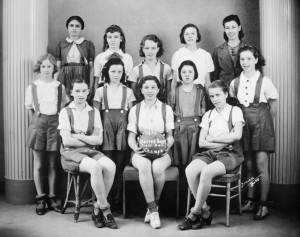
“Some say basketball is a metaphor for life,” mused NBA Hall of Fame coach Phil Jackson during an interview about Montana’s Class C girls’ basketball tradition, “but it’s bigger than that. It’s . . . joy.”
For the first half of the twentieth century, Montana’s young female basketball players knew that joy—sprinting full court in front of enthusiastic crowds. In 1904, ten girls from Fort Shaw Indian School drew enormous Great Falls crowds and beat all rivals at the St. Louis World’s Fair. Phil Jackson’s mother captained her 1927 Wolf Point girls’ basketball team. Patricia Morrison’s 1944-45 Fairfield High girls’ team beat the boys, playing boys’ rules.
But by 1950, mainstream sensibilities and school funding limits had corralled Montana’s exuberant female athletes. Their opportunities became limited to tamer intramural activities—often characterized by cast-off equipment, unskilled coaching, and poor facilities. It took congressional action and a court fight to bring equal opportunity in all sports to Montana’s young women athletes.
The question, of course, was never about girls’ physical prowess or fearlessness. Instead, the issue was equal access to resources. In response, Congress enacted the Education Amendments of 1972. These regulations covered many educational issues, but the best-known section reads, “No person in the United States shall, on the basis of sex, be excluded from participation in, be denied the benefits of, or be subjected to discrimination under any educational program or activity receiving Federal financial assistance.” Though it prohibited gender discrimination in all areas of education, Title IX’s most far-reaching impact occurred in women’s sports.

While Montanans clearly enjoyed women’s sports, many opposed Title IX as unwelcome governmental interference. An op-ed piece in the Billings Gazette called Title IX “federal blackmail.” Educators and school administrators agreed, claiming that the issue “would have worked itself out in a few years.”
Not so. Ten years after Title IX became law, there were still significant disparities between boys’ and girls’ sports. Montana high school girls had fewer sports options than did boys. Boys’ athletics received more money; greater publicity; and better practice times, uniforms, locker rooms, coaches, and transportation. So, in May 1982, a group of female athletes and their parents sued the Montana High School Association (MHSA), alleging that such discrepancies violated Title IX and the equal protection clause of the Fourteenth Amendment.
Karyn Ridgeway, the named plaintiff in Ridgeway v. Montana High School Ass’n, was an all-state basketball player at Missoula’s Hellgate High School. “I defined myself in basketball terms and my self-worth depended on it. . . . I loved the pressure. But it was hard not to notice that the boys’ teams were frequently given the better equipment, facilities and schedules,” she said. With her mother, Karyn attended town hall meetings on the issue. When a moderator asked for volunteers for a test case challenging athletic inequities, Ridgeway stepped up.

The Ridgeway parties arrived at a settlement for the 1985–86 year. The MHSA agreed that districts should offer the same number of sports for girls and boys; all coaches should be equally qualified and compensated; and practice times, uniforms, equipment, publicity, and recognition should be comparable. The agreement also established procedures for filing grievances with the MHSA and the Office of Public Instruction—a crucial element, since federal agencies did not have the resources to investigate Title IX claims, especially in Montana’s smaller school districts.
But the Ridgeway parties could not agree on seasons for girls’ basketball and volleyball. Going against national norms, Montana held girls’ basketball in the fall and girls’ volleyball in winter. The plaintiffs argued that switching seasons would allow athletes to compete in national tournaments and attract college recruiters. But schools resisted the change because splitting boys’ and girls’ basketball seasons allowed them to use the same coaches and facilities. The real issue, a facilitator studying the problem concluded, was “sexually biased attitudes of some of the coaches, athletic directors, administrators and others.” The facilitator concluded that changing seasons wouldn’t fix the fundamental problem.
Proponents for conventional seasons—the final piece of Title IX’s implications—refused to give up. And in 2000, the Montana Human Rights Bureau finally ordered MHSA to make the switch.
A century after young Montana women burst onto the world scene as basketball stars at the St. Louis World’s Fair, Title IX continues to pay big dividends. A track star herself in the 1960s, Bonnie Sheriff, now a coach at Montana Western in Dillon, sees firsthand the benefits of Title IX: “It just kind of strengthened the whole student body, really, by recognizing [girls] as equals.”
Karyn Ridgeway carried the lessons and values of sports with her well into adulthood. After several years of teaching and coaching, she enrolled in medical school. Today, she specializes in emergency medicine. “The ER is fast-paced and stressful—high stakes every day,” she says. So I need to be in the zone and my concentration must be complete. Basketball prepared me for this. It’s like being at the free throw line, needing to make a shot in a crucial game. . . . I’ll be ready when a critical case bursts through the door.” AH and MSW
Read more about the 1904 world champion Fort Shaw women’s basketball team in Champions: The Girls of Fort Shaw.
Check out this video from MontanaPBS: Class C follows five basketball teams from Montana’s smallest schools on their journey to win the state championship. The feature length documentary tells the story of a changing rural America and the girls who carry hope and heartbreak onto the basketball court.
Sources
Bittle, Edgar H., and Larry D. Bartlett. “Recent Developments in Public Education: Committee on Public Education.” The Urban Lawyer 129, no. 4 (Fall 1987), 987-1020.
Cole, Robert. “Title IX: A Long Dazed Journey into Rights.” Phi Delta Kappan 57, no. 9 (May 1976), 575-55, 586.
Kuehn, Amber. “Advocates Say Title IX Has Been Boon for Girls.” Helena Independent Record, May 2, 2012. http://helenair.com/sports/years-of-title-ix-locals-reflect-on-landmark-law/article_6f8c4de8-941a-11e1-be71-001a4bcf887a.html. Accessed Feb. 5, 2014.
_________. “Forty Years of Title IX: Locals Reflect on Landmark Law.” Helena Independent Record, May 2, 2012. http://helenair.com/sports/years-of-title-ix-locals-reflect-on-landmark-law/article_6f8c4de8-941a-11e1-be71-001a4bcf887a.html. Accessed Feb. 5, 2014.
Lintemuth, Elisa. “What Makes a Sports Season Disadvantageous? An Argument That Same-Season Sports Compliance Plans Run Afoul of Title IX.” Michigan State University College of Law, 2010.
Lubke, Jason, and Shasta Grenier. “Class C: The Only Game in Town.” Bozeman: Class C Productions, 2008. http://watch.montanapbs.org/video/2214233556/.
McCallum, Carl W. “Federal Blackmail.” Billings Gazette, Jan. 25, 1976, 3-E.
National Women’s Law Center. “Faces of Title IX: Karyn Ridgeway.” Available online at http://www.nwlc.org/title-ix/karyn-ridgeway. Accessed Feb. 5, 2014.
Ridgeway v. Montana High School Ass’n, 858 F.2d 579, 582 (9th Cir. 1988).
Schafer, Courtney E. “Following the Law, Not the Crowd: The Constitutionality of Nontraditional High School Athletic Seasons.” Duke Law Journal, October 2003, 223-56.
Skidmore, Bill. “Title IX: Changing Quiet Stereotypes?” Helena Independent Record, Dec. 5, 1976, 41.
U.S. Commission on Civil Rights. More Hurdles to Clear (1980). Reprinted as an appendix to Yellow Springs Exempted Village Sch. Dist. Bd. of Educ. v. Ohio High Sch. Athletic Ass’n, 647 F.2d 651 (6th Cir.1981).